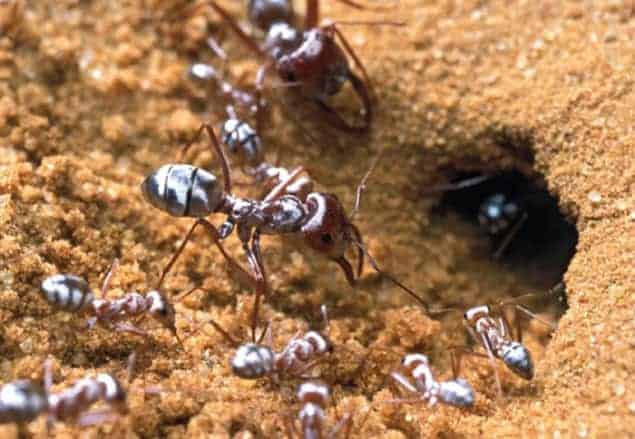
A species of desert-dwelling ant is able to tolerate temperatures exceeding 50 °C because its body hairs act like prisms causing total internal reflection of light, according to the latest work from a team of physicists and biologists in Belgium. The researchers found that the hairs of the Saharan silver ant, Cataglyphis bombycina, provide a 10-fold increase in light reflection, prevent overheating and giving them their silver shimmer.
The Saharan silver ant is one of the most heat-tolerant animals on Earth. The insects can run across the sands of deserts in Egypt and on the Arabian Peninsula at midday, scavenging corpses of animals that succumb to the intense heat. Being able to tolerate temperatures above 50 °C allows them to forage during the hottest part of the day when most other animals, including predatory lizards, are sheltering from the heat.
Solar scavengers
To cope with the high temperatures, the ants limit the amount of time they spend out of their nests to just a few minutes and have evolved a number of physiological adaptations, such as longer legs and the production of heat-shock proteins prior to heat exposure. Last year, researchers in the US and Switzerland found that they also have uniquely shaped triangular hairs that help to reduce their body temperature.
In the latest research, Serge Aron from the Université Libre de Bruxelles in Belgium and colleagues, who weren’t involved in the earlier research, have further investigated the optical and thermoregulatory properties of the ants’ hairs. Using scanning electron microscopy, they confirmed that the hairs – which cover the dorsal side of the ants’ head, thorax and abdomen – are indeed triangular in cross-section. They also saw that the hair’s two upper surfaces (the top two facing away from the ants body, towards the Sun) are corrugated, with parallel groves running oblique to the longitudinal axis of the hairs, while the third side (that sits closest to the body of the ant) is flat and lies parallel to the surface of the ant.
Mirror mirror
Using ray-tracing optical models, the team found that the hairs reflect light like a prism: light enters through the upper surfaces of the hair and then bounces back off the flat bottom surface. For light in the visual spectrum, the reflectance is almost 100% for incidence angles ranging from 35° to 90°. At smaller incidence angles, light does get through, but it is likely to be reflected by other hairs underneath, according to the team. This mirror-like effect gives the ants their silver sheen and reduces heat absorption from sunlight.
The gap between adjacent corrugations (204 nm) is too short to cause diffraction of light. Instead, the researchers calculated that the groves slowly increase the refractive index of light as it enters the hair, reducing the amount of light reflected off the upper surfaces of the hair. “The corrugations increase the amount of light entering each hair and the amount of light exiting the hair after the total internal reflection,” explains Aron. “Overall, they enhance the total reflectance of the ants.”
Hair-loss heat
When the researchers compared shaved ants with unshaved ants, they found that the hairs produced an almost 10-fold increase in light reflection. To test how this affects body temperature, the researchers inserted digital thermometers into the abdomens of dead ants. When they exposed them to simulated Saharan summer midday sun, they found that within 90 seconds, the internal body temperature of hairy ants was up to 2 °C cooler than shaved ants.
Aron told physicsworld.com that if they had cylindrical hairs instead of triangular hairs, “thermal conditions would be unbearable for the ants”. As a result, the ants would either “not inhabit deserts” or would have to change their “biological rhythm, for example by foraging in early morning or late evening, when air and ground temperatures are less elevated – as is the case for most animals living in desert conditions”.
Intriguingly, one of the team, biophysicist Priscilla Simonis from the University of Namur in Belgium, has found that a species of ground-dwelling ant that inhabits rainforests and isn’t exposed to extreme temperatures has also evolved triangular hairs. The researchers suggest that due to the bright sheen that triangular hairs create, they could have evolved for other purposes besides thermoregulation, such as camouflage or communication.
The research is published in PLOS One.



